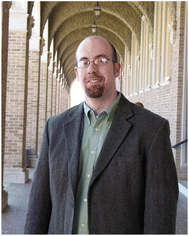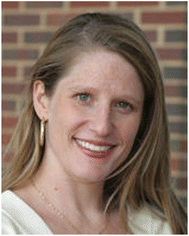DOI:
10.1039/C1AN90056K
(Profile)
Analyst, 2011,
136, 3406-3409
Contributors to the Emerging Investigators Issue
Jeffrey Anker is an Assistant Professor of Chemistry at Clemson with a BS in applied physics (Yale University, 1998), and PhD from the University of Michigan (2005). As a graduate student with Raoul Kopelman he developed magnetically modulated optical nanoprobes (MagMOONs) for chemical and mechanical measurements. For this work, he received a Grand Prize at the 2003 National Inventor's Hall of Fame Collegiate Inventor's Competition. Dr Anker was an NIH Ruth Kirschstein NSRA postdoctoral research fellow under Richard Van Duyne (Northwestern University), where he developed real-time high-resolution plasmonic nanosensors. Current research focuses on developing novel nanosensors and imaging techniques for cell and tissue sensing.
Ryan C. Bailey is an Assistant Professor in the Department of Chemistry at the University of Illinois at Urbana-Champaign and is affiliated with the University's Institute for Genomic Biology and Micro and Nanotechnology Laboratory. Ryan received his BS in Chemistry from Eastern Illinois University in 1999 and his PhD in Chemistry from Northwestern University in 2004, after which he was a joint postdoctoral fellow at the California Institute of Technology and Institute for Systems Biology. His research interests lie in the development of new multiparameter biological analysis technologies for applications in informative disease diagnostics, homeland security, and fundamental biological studies.
Perdita Barran is currently a Senior Lecturer in Biophysical Chemistry at the University of Edinburgh. She graduated from Manchester University with a degree in Chemistry with Industrial Experience (1994), and from Sussex University with a PhD in Chemical Physics (1998). She met Dek Woolfson at Sussex in 2000 and he suggested zinc fingers as a good target for IM-MS. After a postdoctoral appointment at UCSB, Perdita was awarded an EPSRC Advanced Research Fellowship which allowed her to commence independent research at Edinburgh University (2003).
Christa Brosseau is from Halifax, Nova Scotia. She attended Dalhousie University (BSc) and Acadia University (MSc) before going on to complete a PhD in interfacial electrochemistry and vibrational spectroscopy under the supervision of Jacek Lipkowski at the University of Guelph in Ontario, Canada. She was a postdoctoral fellow in the laboratory of Richard Van Duyne, and worked towards the application of SERS analysis of paintings and textiles. Christa is currently an assistant professor of chemistry at Saint Mary's University in Halifax, Nova Scotia, where her research group focuses on the application of electrochemical surface-enhanced vibrational spectroscopy to varied systems ranging from biomembranes to ionic liquids.
Christopher J. Easley earned his B.S. in Chemistry (2002) at Mississippi State University and his Ph.D. in Analytical Chemistry (2006) from the University of Virginia. Dr. Easley’s postdoctoral work (2006–2008) was conducted in the Molecular Physiology and Biophysics Department at the Vanderbilt University Medical Center, after which he moved to Auburn University as an Assistant Professor in the Chemistry and Biochemistry Department. The Easley laboratory at Auburn is focused on the development of microfluidic techniques for fundamental studies on murine islets and adipocytes, as well as the development of aptamer- or antibody-based small-volume assays to complement these microfluidic systems.
Amanda J. Haes is currently an Assistant Professor in the Chemistry Department at the University of Iowa. She completed her Ph.D. in Chemistry at Northwestern University with Richard P. Van Duyne. Before beginning her independent career, she was a National Research Council Research Associate with Greg E. Collins at the U.S. Naval Research Laboratory. Haes group research activities include designing and purifying novel nanomaterials for stable spectroscopic studies, improving detection limits of biological and environmental pathogens, and investigating how surface chemistry impacts nanomaterial function in separations and spectroscopy.
Christy Haynes was an undergraduate at Macalester College, a graduate student at Northwestern University, and a postdoctoral fellow at University of North Carolina, Chapel Hill – all in the field of Chemistry. She currently mentors a group of nine doctoral students and as many undergraduate researchers at the University of Minnesota where her group develops analytical techniques to explore questions in immunology, toxicology, and hematology while also keeping an active materials chemistry effort. When not working, Christy does urban scavenger hunts with her group members, bakes, and plays with her 3 year old son.
Andrew Hudson received his training in molecular spectroscopy and dynamics in the group headed by John Polanyi at the University of Toronto, where he obtained his Ph.D. in 1998. This was followed by postdoctoral appointments in applied science in chemistry and engineering departments. He then took a role as a senior scientist in a start-up company in North America developing optical technologies for telecommunications and medical diagnostics. He obtained an EPSRC Advanced Research Fellowship in 2005, returning to academia at the University of Bristol, before moving to a permanent position in the Department of Chemistry at the University of Leicester.
Suwan N. Jayasinghe started his academic career in the UK at Brunel University, where he received his first and second degrees in Mechanical Engineering. Subsequently he joined Queen Mary, University of London, where he studied Materials Sciences and earned his PhD. In January 2005 he became an independent researcher at which time he instigated the BioPhysics Group, now based in the Department of Mechanical Engineering at University College London. His group has made several discoveries having significance to advanced bio-analysis and diagnostics to tissue engineering and regenerative/therapeutic biology and medicine. These pioneering investigations are currently undergoing intense exploration for their possible exploitation in the clinic.
Andreu Llobera obtained his PhD in Physics from the Universitat Autónoma de Barcelona in 2002. Since 2009 he holds a permanent position as researcher at the IMB-CNM-CSIC. He has participated in several research projects financed by the Spanish Government and by the European Community, has co-authored 65 published articles, with a total of 384 citations and an h factor of twelve. He has contributed with 75 works to international conferences. His research activities include integrated optics devices, micro-opto-electro-mechanical systems (MOEMS) and lab-on-a-chip platforms. Finally, Dr Llobera was awarded with a Starting Grant of the European Research Council in 2008.
Hajime Miyaguchi was born in Japan, in 1971. He received his BSc from Tokyo Institute of Technology in 1994 under the direction of Professor Yoshio Okahata, and he received his MSc from the University of Tokyo in 1996 under the direction of Professor Shigeyuki Yokoyama. In 1997 he joined the Saitama Prefectural Police Headquarters. Since 2003 he joined the National Research Institute of Police Science. He received his PhD in analytical chemistry from the University of Tokyo in 2009 under the direction of Professor Takehiko Kitamori. His research interests are developing advanced and user-friendly sample-preparation techniques for biological specimens.
Aydogan Ozcan received his Ph.D. degree at Stanford University Electrical Engineering (EE) Department. He joined UCLA in 2007 as an Assistant Professor of EE, where he is currently leading the Bio-Photonics Laboratory. He holds 17 issued patents and another 8 pending patent applications and is also the author of one book and the co-author of more than 150 peer-reviewed articles in major journals and conferences. Prof. Ozcan received various awards including NSF CAREER Award, NIH Director’s New Innovator Award, ONR Young Investigator Award, IEEE Photonics Society Young Investigator Award, MIT's TR35 Award, National Geographic Emerging Explorer Award,
etc.
Dimitri Pappas is an Assistant Professor at Texas Tech University. He received his Ph.D. from the University of Florida in 2002 and was a senior scientist at Johnson Space Center before assuming his faculty position. His students focus their attentions on microfluidic and single-molecule spectroscopic assays for cell analysis. His group works extensively in the areas of integrated cell analysis devices for the study of cancer and heart disease.
Christine Payne earned an S.B. in Chemistry from the University of Chicago (1998) and a Ph.D. in Chemistry from the University of California, Berkeley (2003). Her Ph.D. research, studying the rearrangement of ligands in organometallic complexes using femtosecond spectroscopy, was carried out under the mentorship of Prof. Charles Harris. Prof. Payne spent 2003–2006 as an NIH NRSA Postdoctoral Fellow at Harvard University in the lab of Prof. Xiaowei Zhuang. She joined the faculty of the School of Chemistry and Biochemistry at Georgia Tech in 2007. Prof. Payne has received many honors including an NIH Director’s New Innovator Award in 2009.
Brandon T. Ruotolo is currently an Assistant Professor in the Department of Chemistry, University of Michigan. He earned his PhD from Texas A&M University in 2004 under the direction of David H. Russell. He did his post-doctoral work at the University of Cambridge with Carol V. Robinson, and was awarded the first ever Waters Research Fellowship in 2008. He is the recipient of many other awards and honors, including the 2011 ASMS Research Award. His research is focused on both developing ion mobility- mass spectrometry as a tool for structural biology and understanding the influence of solvent on protein structure.
Emily Smith received a Bachelor’s degree from Northwestern University and graduate degrees in chemistry from Pennsylvania State University (M.S.) and University of Wisconsin-Madison (Ph.D.). Her postdoctoral appointment was at University of Delaware and she was a Ruth L. Kirschstein National Research Service Award Postdoctoral Fellow at University of Arizona. She is currently an Assistant Professor of Chemistry at Iowa State University and an Associate Scientist at U.S. Department of Energy, Ames Laboratory. Her research interests are instrument development for analysis of nanomaterials, plant and animal tissue; and understanding the molecular events that lead to organization of the cell membrane.
Leslie Sombers is an electroanalytical chemist interested in the development and application of new biosensing platforms. She is pioneering the use of fast-scan cyclic voltammetry for the detection of hydrogen peroxide, and has worked to improve the electrochemical detection and analysis of neurotransmitter release events in biological preparations ranging from individual cells through awake, freely-moving animals. Professor Sombers has won an NIH Early Career Award in the Chemistry of Drug Abuse and Addiction, and a Kirschstein National Research Service Award. She holds a Ph.D. from Penn State University and was a Postdoctoral Fellow at the University of North Carolina-Chapel Hill.
Jill Venton is an Assistant Professor of Chemistry at University of Virginia where she also has a joint appointment in the Neuroscience Graduate Program. Her research interests lie at the intersection between analytical chemistry and neuroscience. Her lab develops better microelectrodes and extends their use for new analytical applications. In addition, her lab develops rapid capillary electrophoresis separations for understanding neurochemical changes. The Venton lab applies analytical chemistry to real measurements of neurotransmitters and neuromodulators in model systems from the fruit fly to rats.
|
| This journal is © The Royal Society of Chemistry 2011 |
Click here to see how this site uses Cookies. View our privacy policy here. 

















